Scandinavian is a pool of talent – in recent years, more and more potential top players have come from those nations. Tottenham‘s Dejan Kulusevski and Man United player Anthony Elanga are two Swedish players who caught people’s eyes in the Premier League recently, while the likes of Patrik Wålemark and Williot Swedberg attracted eyeballs Allsvenskan 2021.
Apart from these names, there is another young player, who has been impressive, and should deserve more attention from the public. He is Roony Bardghji, who has an amazing story – making his debut at FC København six days after celebrating his 16-year-old birthday.
Bardghji has an interesting story. It began in Kuwait, where he was born in Kuwait City. In 2012, he arrived in Sweden and finally got into the Malmö FF academy, but København snapped up this wonderkid in 2020. Recently, Bardghji got more and more chances from Jess Thorup, helping his side to secure consecutive victories, including the huge win on Midtjylland to gain a six-point margin with a 15+ goal differences advantage. This tactical analysis will give a detailed profile of Bardghji, and explain why he could be the biggest Scandinavian star, if not in world football, in the future.
Data analysis
Bardghji has been playing on the flanks for København, mostly on the right side as the winger. But he was so young and therefore, he might be developed as a central player in the future when the timing was right. Firstly, we evaluate his performance with numbers to see where he ranked compared to other wingers in the Danish Superliga this season.
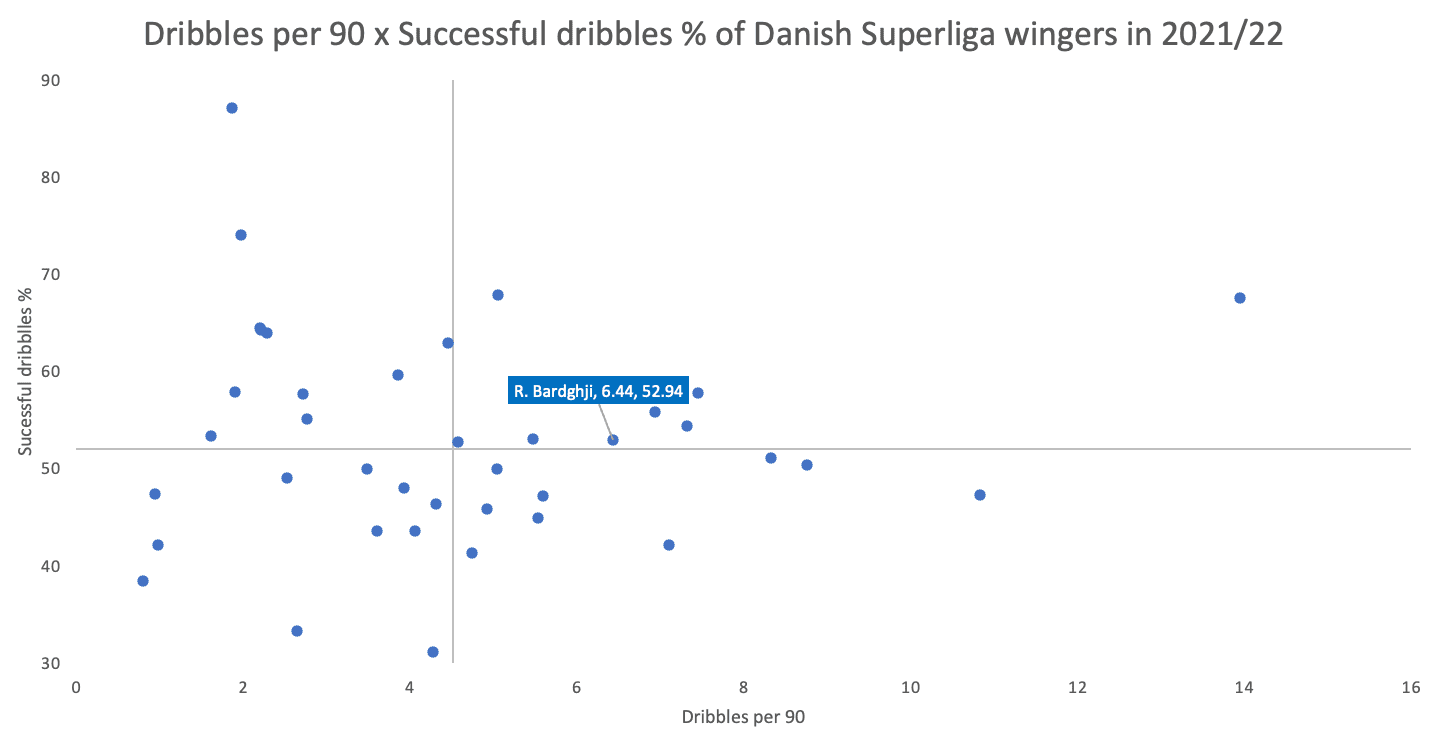
Firstly, we look at his dribbling. Bardghji averaged 6.44 dribbles per 90, which shows he was very confident on the ball, and willing to challenge the opposition as the figure was higher than the mean. His success rate was 52.94%, which was slightly above the mean. These numbers suggested he was doing fine in dribbling.
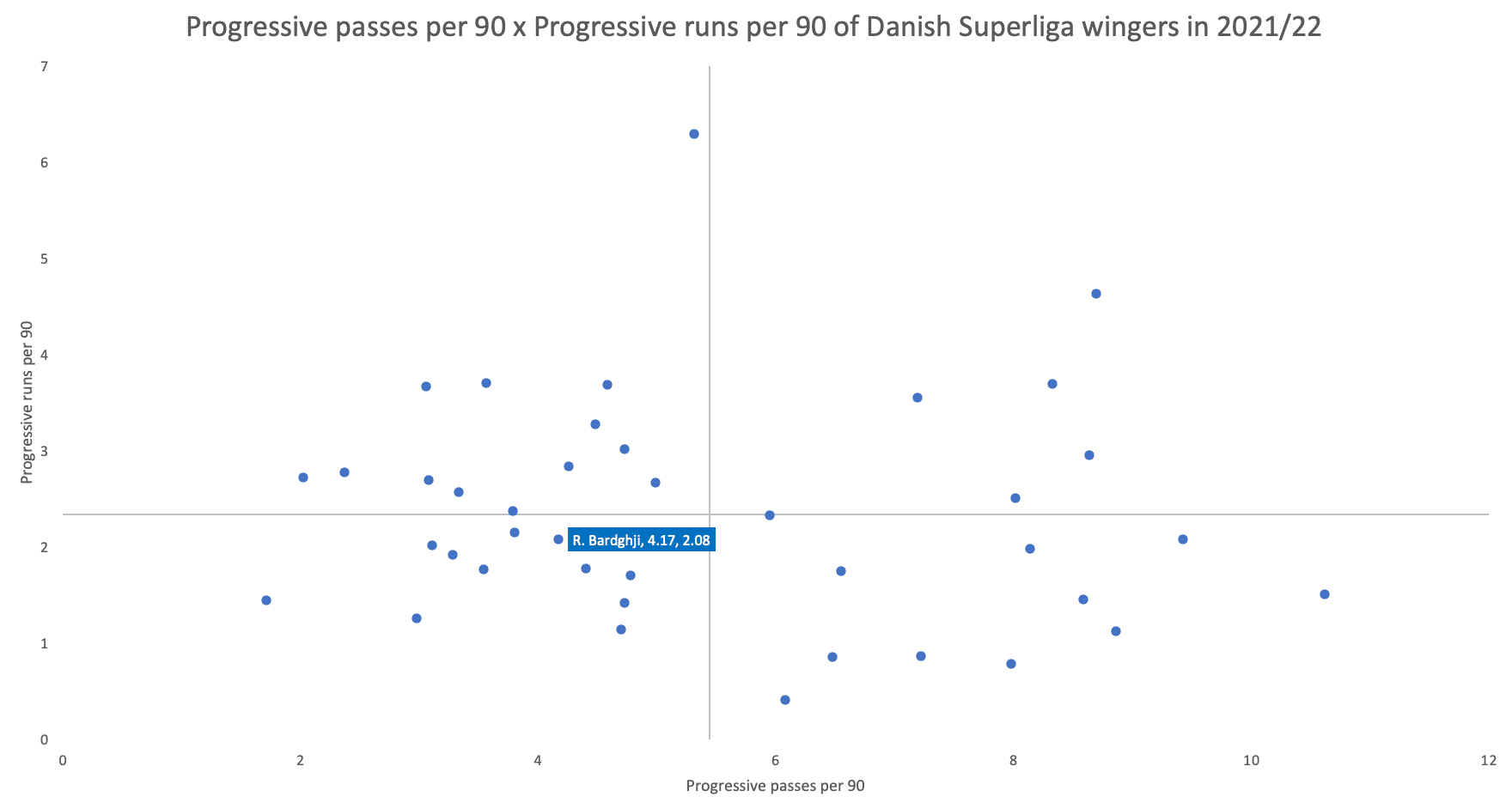
However, in terms of progressive passes per 90 and progressive runs per 90, Bardghji’s name appeared on the bottom-left quadrant, this means he was not good at both metrics (4.17 progressive passes per 90 and 2.08 progressive runs per 90). Nevertheless, his relatively low participation in the advancement of the attack, can also be explained by his position. Since he rarely played deep, it was normal that he was left out in the construction phases of the attack.
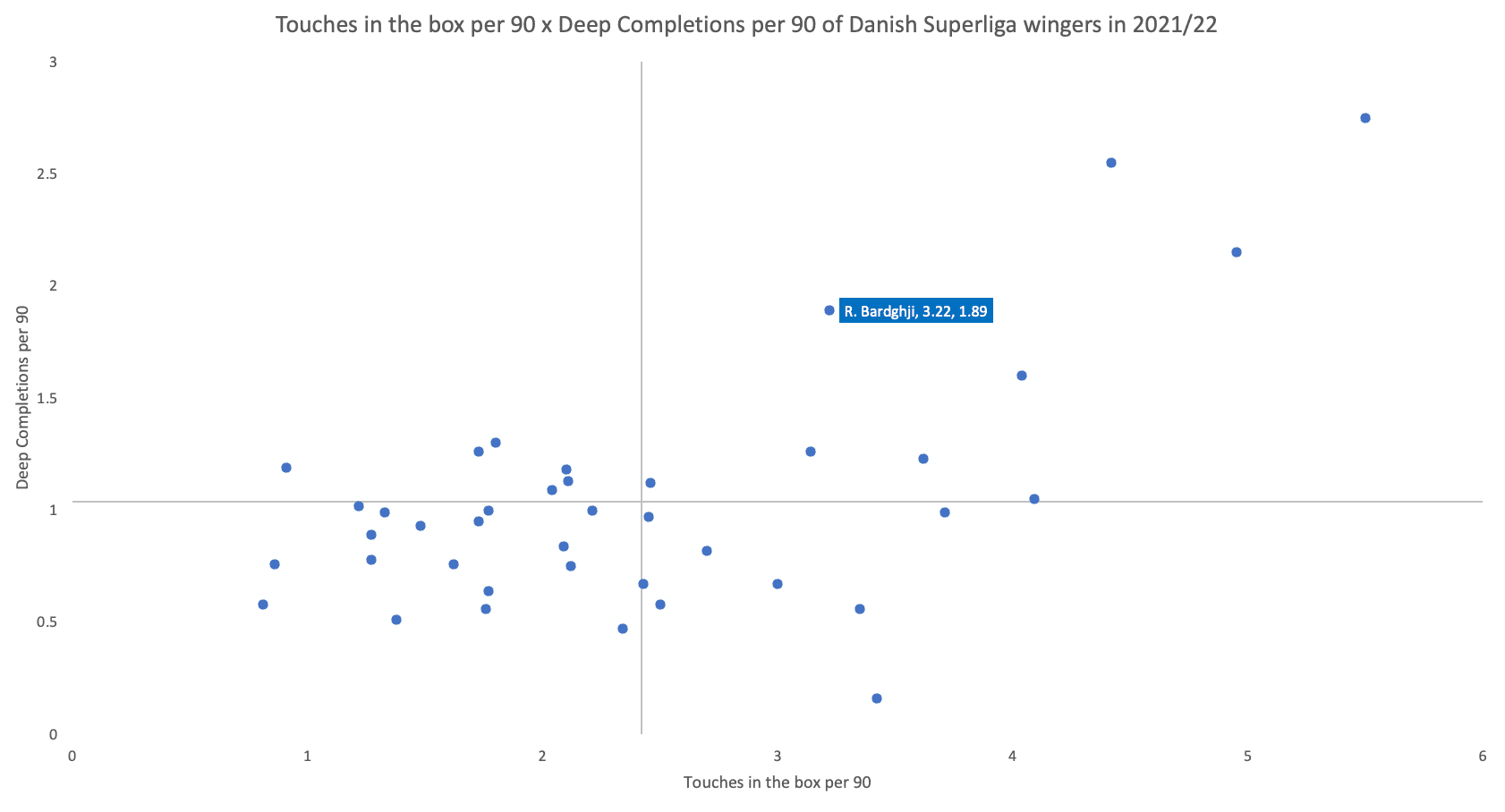
As you can see, in terms of the participation in the last third, Bardghji was quite impressive as a 16-year-old player. He has 3.22 touches in the penalty box per 90, and 1.89 deep completions per 90, showing that he could both receive in the box and put the ball into the six-yard box.
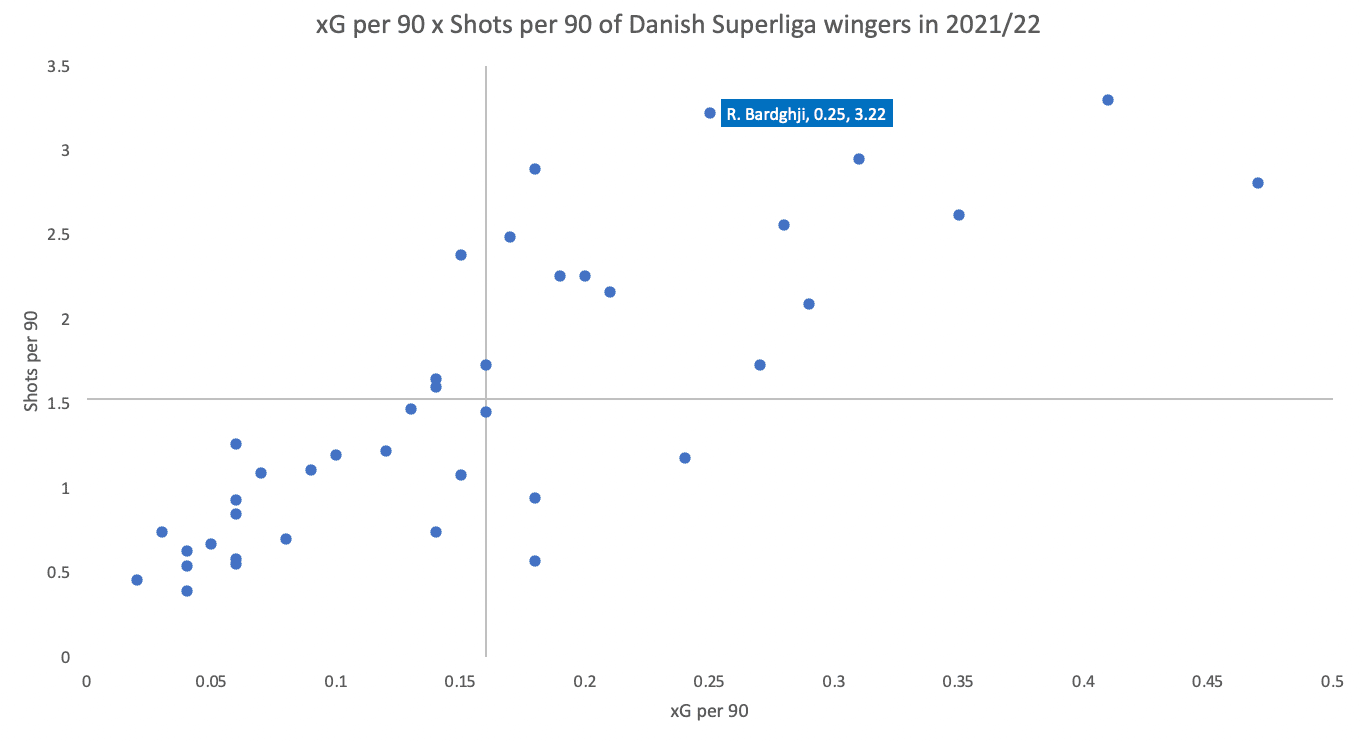
Further, when looking at his xG per 90 and shots per 90, his threat to goal was reflected. Bardghji’s xG per 90 was quite high, ranking in the top group of Danish Superliga wingers at 0.25. While he has this number because he took quite a lot of shots, 3.22 shots per 90 was the second-highest on the list. But you can also see, the positions he pulled the trigger could be better because, with a similar frequency of shots, players liked Anders Dreyer (0.41 xG per 90 from 3.3 shots per 90) and Sebastian Jørgensen (0.47 xG per 90 from 2.81 shots per 90) was generating higher xG per 90.
Textbook dribbling sense
Above all, the biggest strength of Bardghji is his technical ability combined with physical gifts. As an attacking player, his balancing and body coordination was so good that allowed him to twist and turn continuously within seconds, while he also had a good level of techniques to do tricks and apply different skillsets to beat the defender.

But dribbling is not about 1v1, the most valuable aspect was not beating the man, instead, it was more about how to apply and integrate into the game context to help the team. This was a part in which Bardghji was extremely outstanding, because, at the age of 16, he already learned “how to dribble”. Currently, in the Danish Superliga, he already showed the ability to dribble towards the defender, the opponents always felt his presence and threat, or even willing to commit more than one player to stop him.
But Bardghji’s intention might not be always going past the defender. He could use dribbling as a tool to search for another angle of passing, or wait for better timing to release teammates. That means he could bring the right-back in play, as we have looked into this collaboration between Bardghji and Peter Ankersen.
Initially, Bardghji had the ball on the right side while the right-back was running from deep, nothing happened yet and Bardghji showed very good courage by dribbling towards the defender.
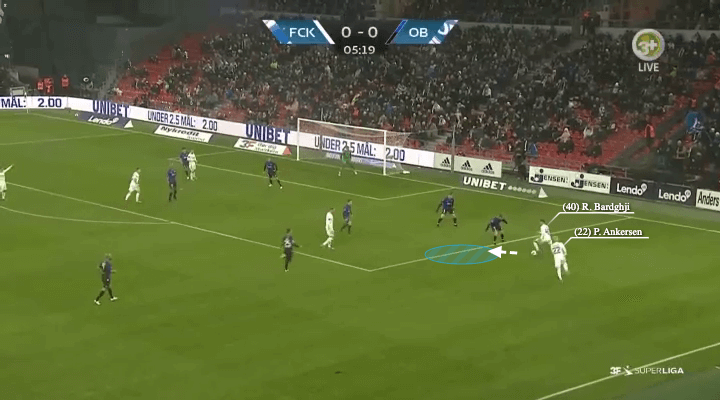
It was important because the dribbling itself was meaningless if they did not create dynamics or pose questions to the opponents. Bardghji’s style was always going to drive towards a defender, with good physical qualities to help him suddenly change a direction, he wanted to see whether the defender would be impatient. If the defender rushed and tried to win the ball, Bardghji would very quickly shift the ball to an opposite angle to escape the challenge as he had a good awareness of what the defender was doing.
But if the defender was patient, at least he would keep retreating as Bardghji was going in his direction, which means spaces were created elsewhere.
Back to the example, now you can see, Bardghji’s dribble changed a bit, instead of going towards the player, he intended to access the blue zone to cut-in, just like many wrong-footed wingers such as Manchester City’s Riyad Mahrez or Liverpool’s Mohamed Salah. The dribbling of Bardghji also bought time as Ankersen almost arrived at the byline, constituting a temporary 2v1 on the left-back.
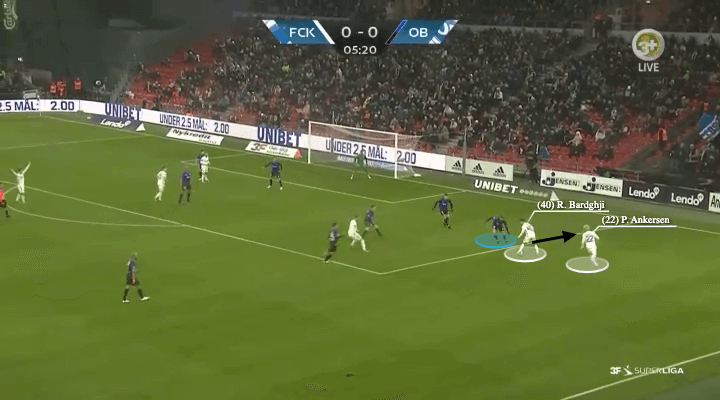
Now, the next action depended on the opponent because it was a 2v1. This time, the defender tried to narrow down spaces in the inside to prevent a cut-in, as you could spot from the body angle. Then, because the ball was tightly under Bardghji’s feet, he could dictate, decide, and execute what he wanted based on that information. As the angle to the byline was shown, he just simply released Ankersen to cross.
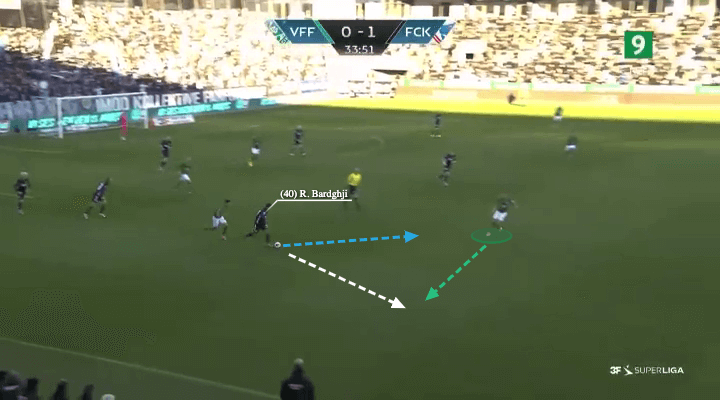
We can see another good example of Bardghji’s dribbling, this was also applicable in transitions, not only the attacking phases. On this occasion, København won the ball back and now they were trying to develop something from there. Instead of early passing, Bardghji tended to use dribbling as a solution. Hence, he did not release the striker early, but he continued carrying the ball forward.
But what is the direction of dribbling? Average players would take the white route because there was more open space, but the opponent could also close that down very easily.
Bardghji was different, he has the courage to dribble towards the opponent, which was the blue route, diagonally.
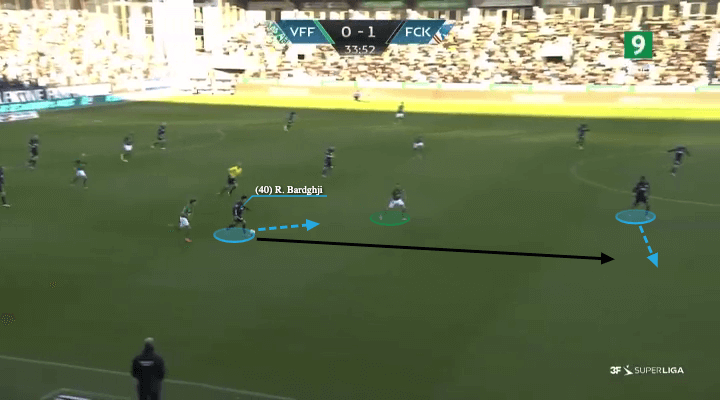
As a result of Bardghji’s diagonal dribbling, the passing lane to the striker was opened. The Viborg defender could not block that passing lane because Bardghji was charging towards him, and to the centre.
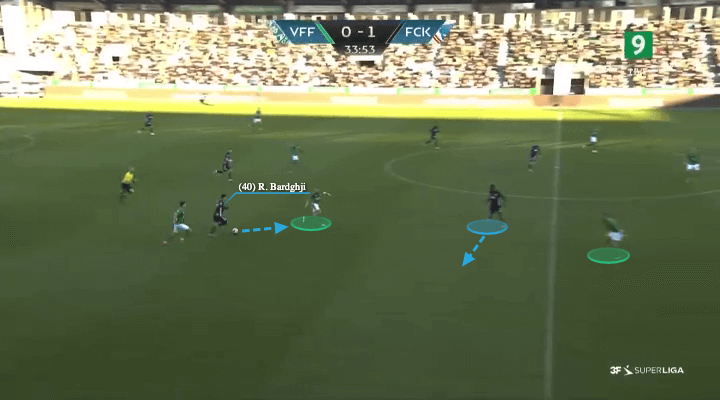
But Bardghji did not release the striker. One second later, he was much closer to the opponent in the centre, which forced the defender to retreat because he did not engage. But many players would also lose their balance when dropping back in that way continuously, now, he could not do double-press if the striker was released. But Bardghji did not release the striker.
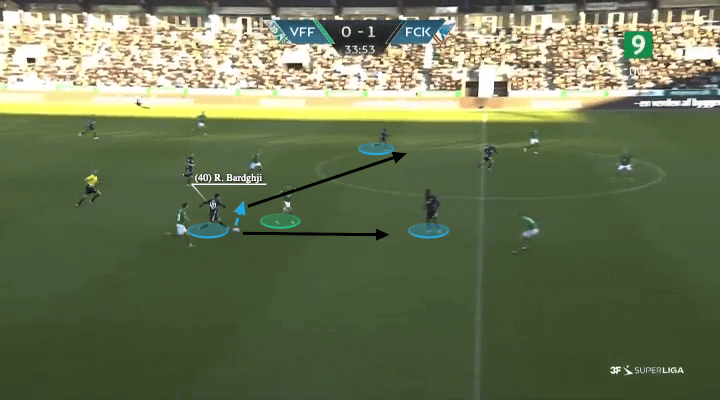
Now, probably a 0.5s later, he finally passed to the striker but the receiver did not control well. But instead, there was a better option if Bardghji developed the mindset to see further situations on the pitch. Since the defender was off-balance already, Bardghji could have taken one more touch laterally to the inside, then, find those diagonal options, that could be a route or approach used by many teams in Europe. But now, sometimes his vision was not opened or he was not aware of those passing options enough.
Movements and positioning
Apart from dribbling, we noted how Bardghji’s movements and positions on the pitch in this section of the analysis.
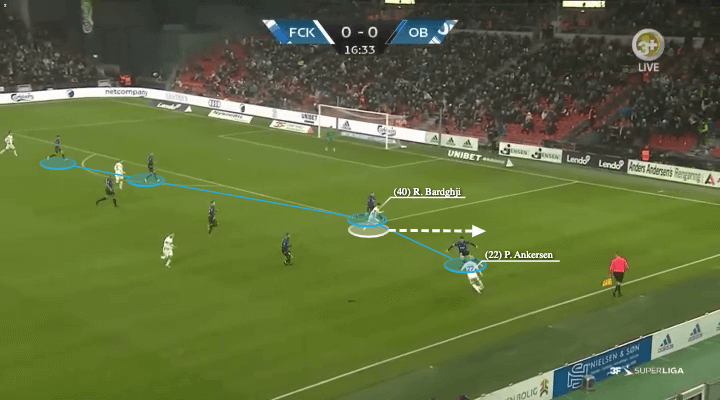
Bardghji had the potential to be a top player because he demonstrated good adaptability to the game. Since football was so dynamic, the situation changed very quickly, the best players in the world must be able to change decisions quickly to search for the best conditions constantly, as this “best condition” can be defined very differently one second before and one second later.
In the above example, Bardghji showed this quality with his run. Initially, when Ankersen had the ball outside, the youngster from Malmö academy made a diagonal outside run.
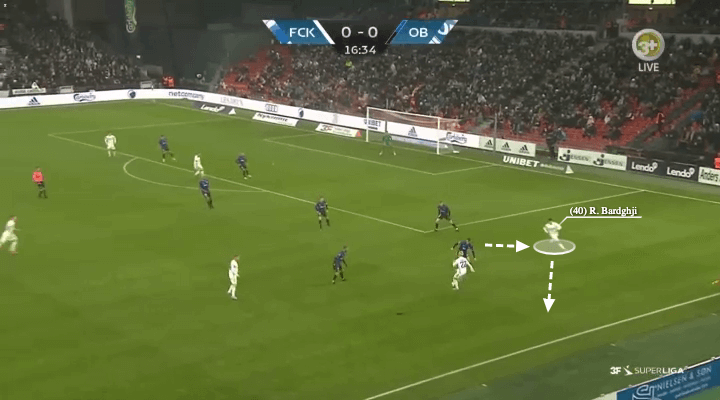
However, the pass did not come, and Bardghji was offside, as a result. But he did not stop, instead, quickly changed the direction of his run to get back on the side, looking for another opportunity to receive.
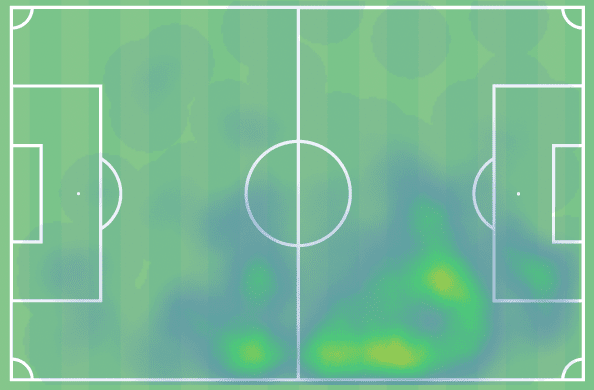
Nevertheless, if you looked at the heat map of Bardghji, you could see he was missing the presence in zone 18, on the far right close to the byline. As a left-winger, he must learn to exercise his skillsets in the half-spaces and in the wide spaces, because he had the dribbling technique to attack the defenders. But of course, Bardghji was so young and he could also develop in the centre, maybe like a 10 if his game awareness was improved, it could change a lot in the future so it was difficult to say now.
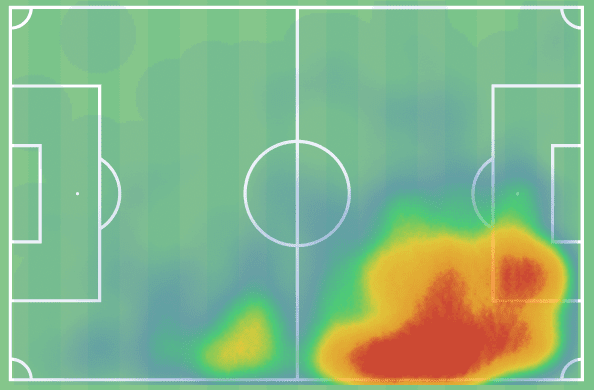
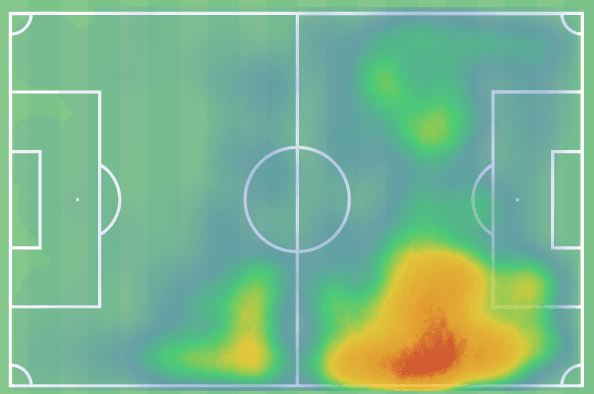
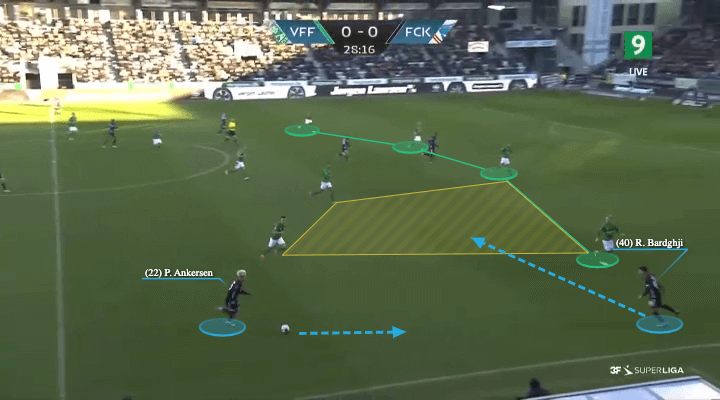
Through this example, you may see why Bardghji was not playing in zone 18 a lot. Because he was a wrong-footed winger, he tended to drop out to receive so there was a larger angle to play. Another reason was the setup of København, the right-back, Ankersen also played in that wide channel, so Bardghji stayed inner more often.
Here, since Ankersen was carrying the ball forward in the outside, Bardghji drifted inside to vacate the zone.
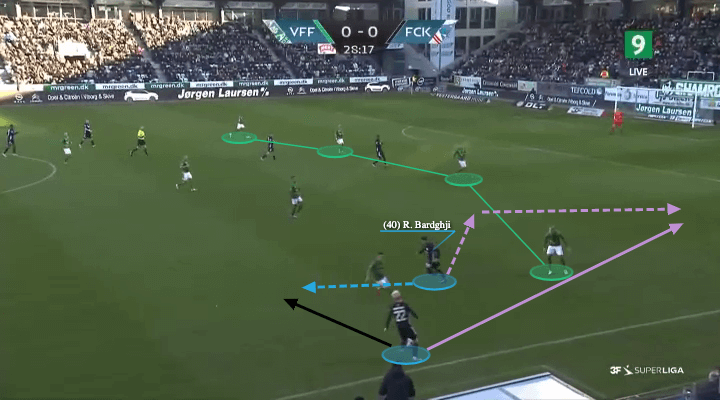
But guess where was he going after that? He took the blue route to receive outside of the lines, instead of exploiting spaces behind the left-back given Ankersen fixed the left-back’s attention. For an aggressive winger like Raheem Sterling or Leroy Sané, they would have taken the purple route to push the last line, but now Bardghji tended to play outside more, which was more comfortable and natural for him.
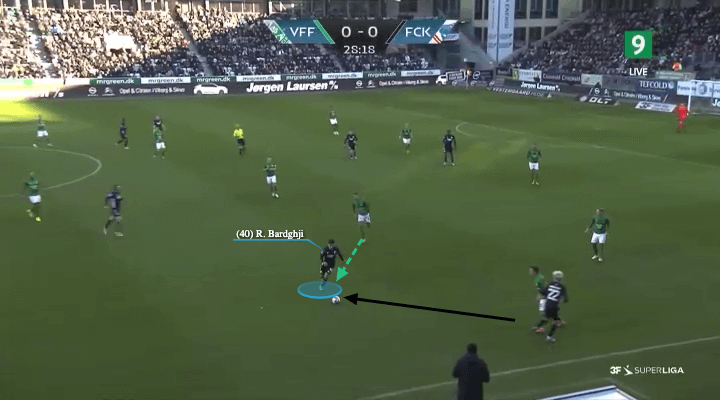
Again, in this example against Randers, the running route of Bardghji was less clever. When Ankersen was driving forward, Bardghji took the white route as he wanted to receive behind, but that was easier for the left-back to defend, because the 16-year-old youngster just simply moved in front of the defender.
A possible option could be the green route, which Bardghji could first go inside and move via the blindside of the defender, this might delay the timing of the arrival, but it was very fine given the pass was not ready to be played yet, and he might be without marking if the centre-back did not track.
Before receiving the ball
Regarding Bardghji’s quality on the ball, we have addressed most of them in this article, but in the elite level of football, many things were determined by how the players behaved before the ball arrived at their feet. It was also very impressive to see Bardghji doing these little things very correctly, so the condition he received was good.
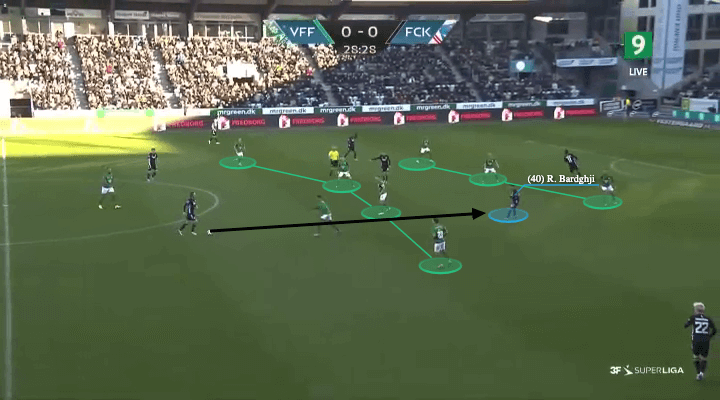
As a winger, Bardghji was not a typical wide player who stayed on the outside only. He also had good spatial awareness and move into spaces between the lines. That would also the right-back of his team to move up higher to attack the wide channel, as shown in the above image.
Bardghji was found by a vertical pass, notice his body orientation, initially, it was not entirely closed but the angle was very limited.
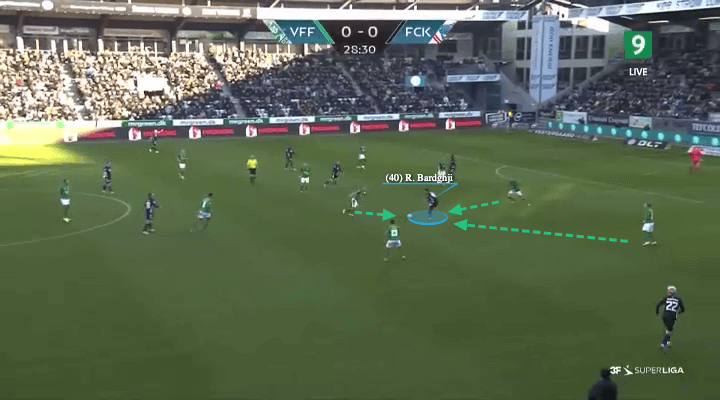
And, within seconds, in this image above, you could see how Bardghji adjusted his body angle quickly, a bit more open here. Strategically his blindside was the corner flag, an area of the pitch which possessed the lowest tactical value.
Also, because he adjusted the angle a bit, now he spots the pressing from the Viborg midfielder, it was easy to escape, and he would not put his blindside on the centre-backs, which made him easier to turn to the centre as well.
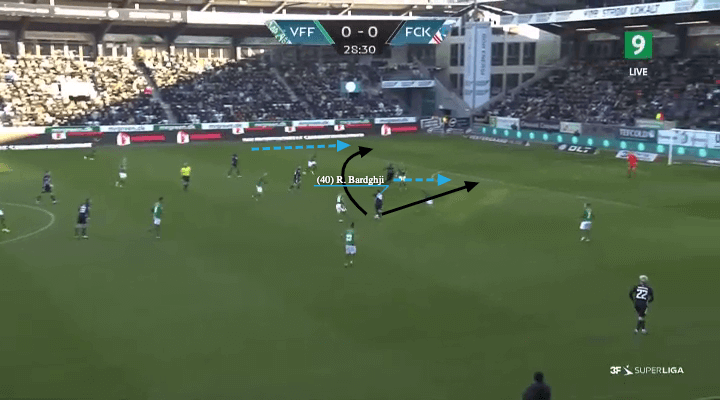
As Bardghji’s preparation before receiving the ball was good, now, as shown in the above screenshot, there were more viable options if København players presented the runs, such as the through pass behind. Of course, Bardghji needed to improve his awareness to see these passing routes and released teammates in these situations, at times he kept the ball too long, which was very normal from a 16-year-old youngster.
By contrast, if he closed his body and place the blindside to the centre-back when receiving, he needed a greater turn and slowed things down.
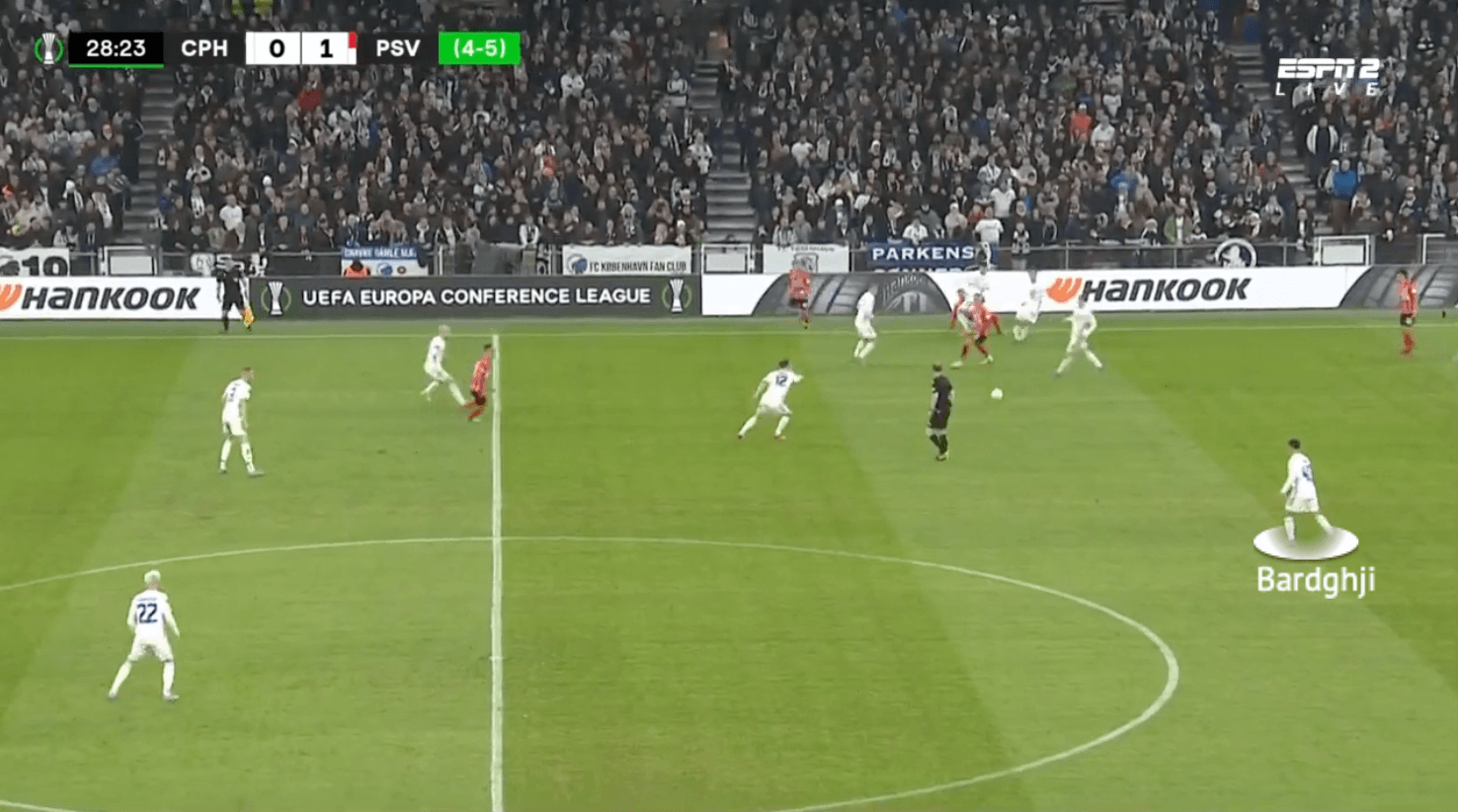
Another example here from the PSV game, from a throw-in, the ball was going to the centre and Bardghji was there.
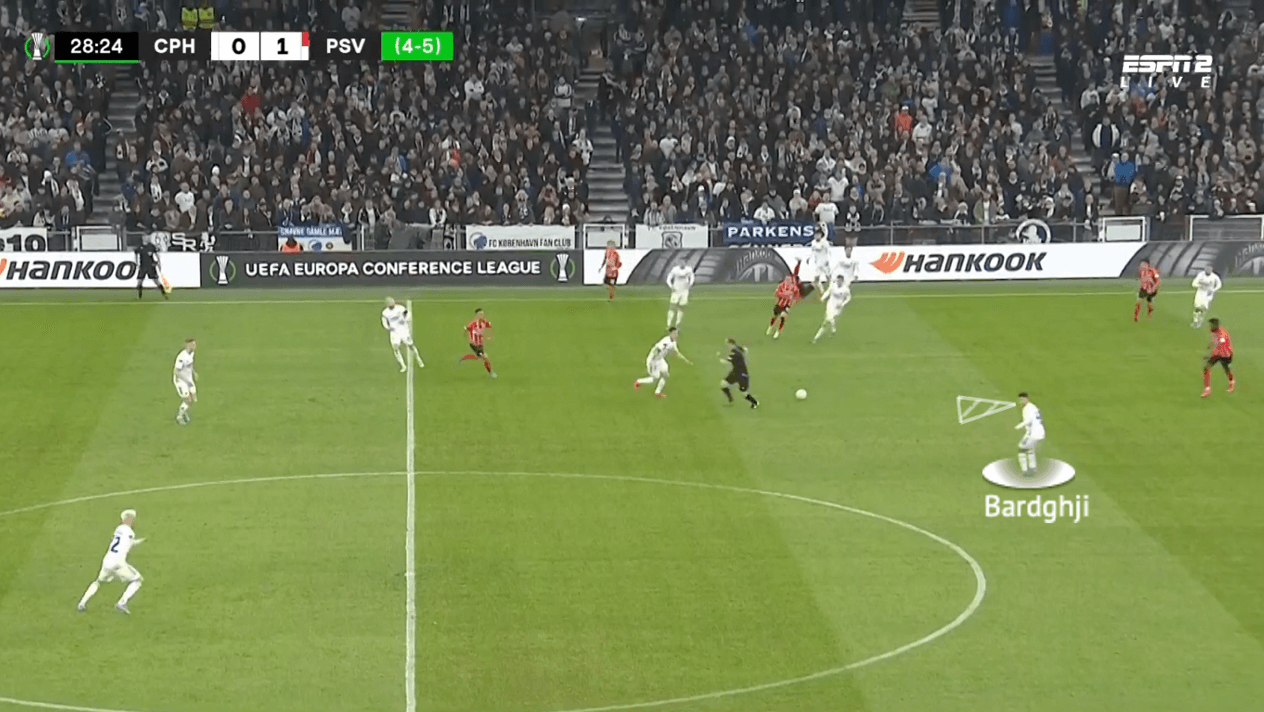
Before the ball arrived, Bardghji already checked the position of the full-back, at least twice within three seconds and we only included one of them here. So, he perceived Ankersen’s move.
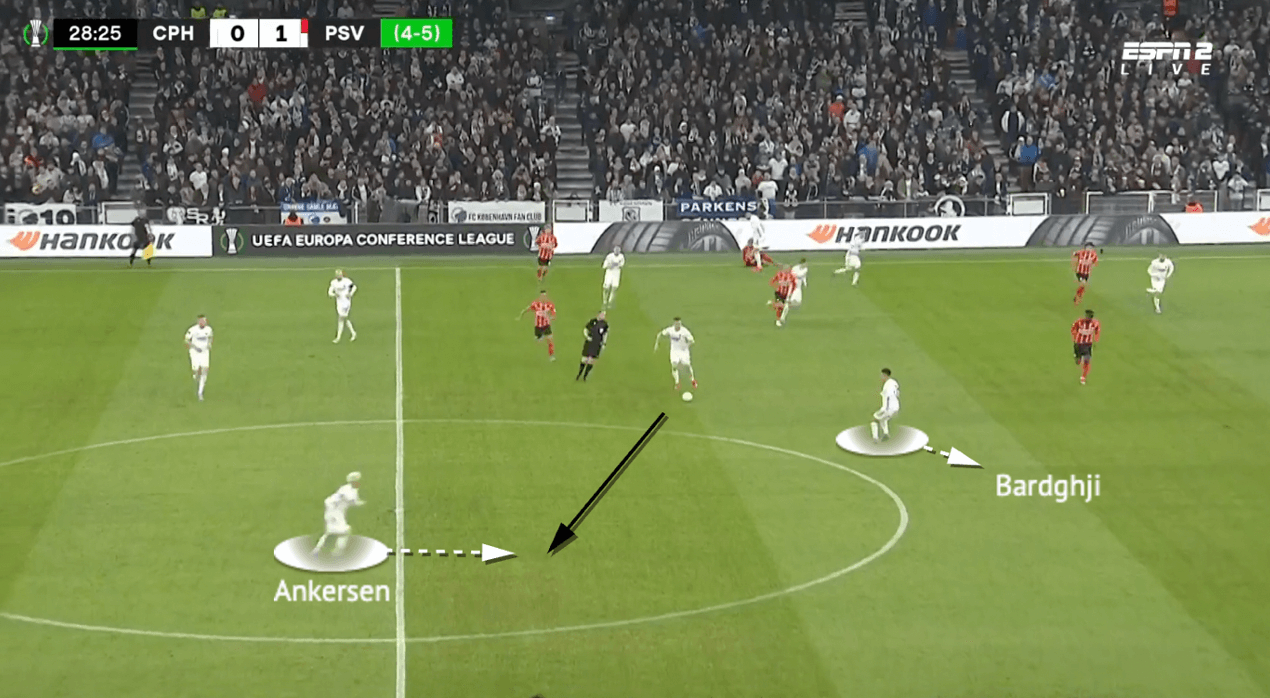
With that visual perception of Ankersen’s move, Bardghji realized he could be a bit higher to vacate that space for the right-back. Another good quality of this player was his body adjustments without the ball, he was never static, contrarily, kept moving with small steps to adapt, that was the prerequisite to make things good when the ball arrived.
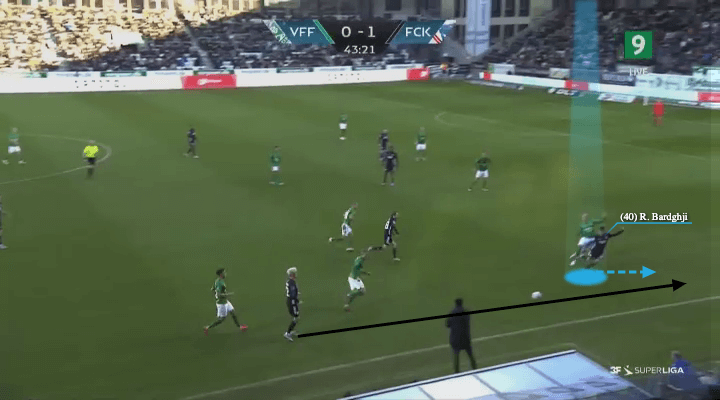
When Bardghji was playing in spaces, it was tricky for the defenders, because if he got too tight, Bardghji could dismark with his quick decisions. It was also one of his demonstrations of game adaptations, here, when the defender stayed very close, Bardghji just used a no-touch turn sharply to escape from the marking.
Defending
When the team was without possession, Bardghji had a long way to go, we are not talking about cliché tactics such as helping the full-back out, but more about the tactical concepts behind. For example, he might need a bit more intensity, even though he was not sizable, but a relatively “tiny” player like Phil Foden could also inject that intensity, so this might be one aspect that Bardghji could develop.
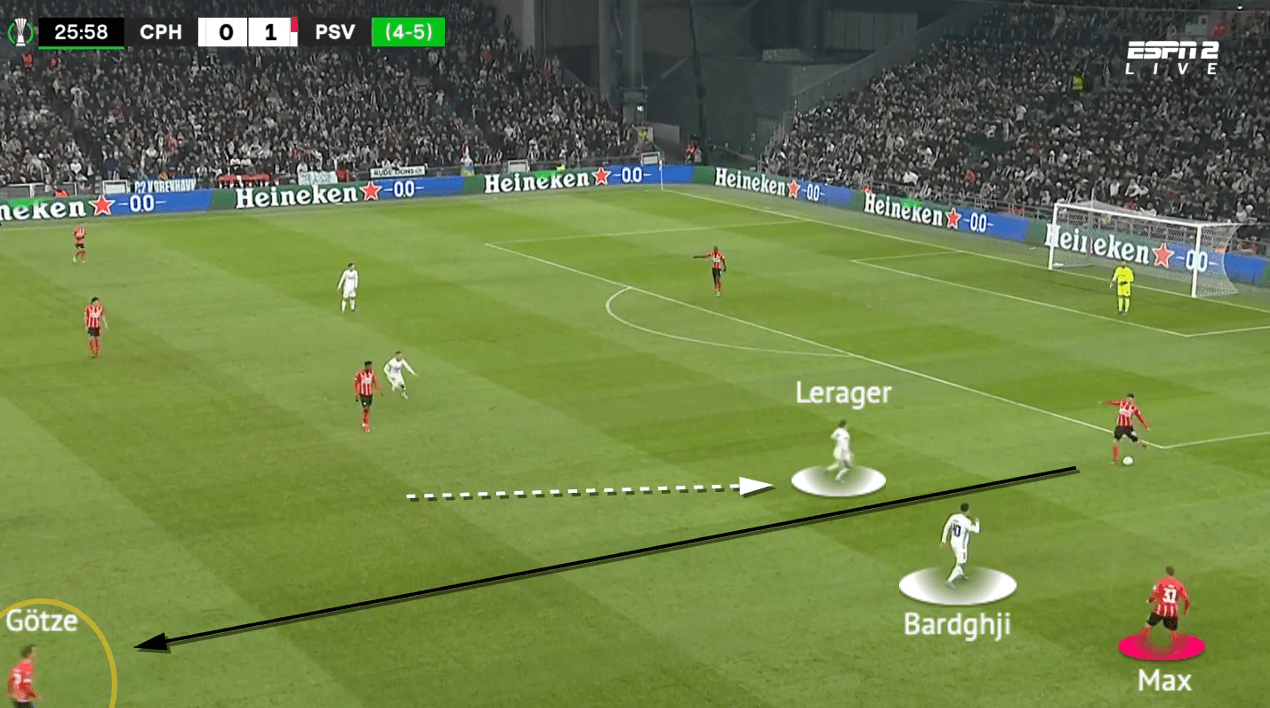
So far, Bardghji’s defending mainly used the left-back as a reference point of his move, the way he ran or how he angled himself without the ball was based on that. For example, he was quite oriented to Philipp Max on the above occasion, which was not bad because he closed that left-back option. However, that also exposed the vertical channel in half-spaces, so the centre-back could hit through to progress the attack.
When Bardghji grew older, the coaches would have more expectations, for example, defending was one of them while the attacking moves could be another area in which Bardghji needed improvements. But it was normal because every talent had different strengths, experiences, and stories behind it, for example, Brenden Aaronson at RB Salzburg might have less quality on the ball but his pressing was so good.
Conclusion
As we have shown in this tactical analysis, Bardghji possessed the potential and qualities to be one of the best players in the world. Even though there are many weaknesses being pointed out in the scout report as well, it was very normal because he was only 16-year-old, you cannot expect that he is a perfect and fully-grown profile. It was very impressive, at his age, Bardghji was doing something naturally, while many older elite players took time to learn some of those concepts and skillsets – that’s why Bardghji is special.
To be a world-class player, much more effort were required but at least Bardghji showed the potential to reach that level – incredible talent.





Comments